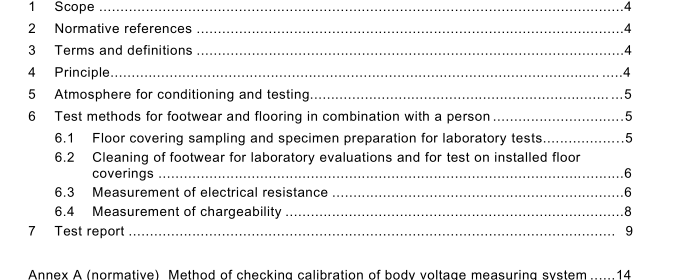BS EN 61340-4-5:2004 – Electrostatics — Part 4-5: Standard test methods for specific applications — Methods for characterizing the electrostatic protection of footwear and flooring in combination with a person

5 Atmosphere for conditioning and testing The following requirements supersede any other specification for the atmosphere for conditioning and testing that may be given in one or more of the documents referred to in this standard. Unless otherwise agreed, the atmosphere for conditioning and testing for laboratory evaluations shall be (23 ± 2) °C and (1 2 ± 3) % relative humidity. The conditioning time prior to testing shall be at least 48 h.
Textile floor coverings are preferably pre-conditioned for at least 24 h at (20 ± 2) °C and (65 ± 3) % relative humidity prior to conditioning and testing. During pre-conditioning and conditioning, specimens shall be placed on a rack or other suitable support that allows free circulation of air around them. Whenever tests are made in uncontrolled conditions, e.g. tests on installed floors, the ambient temperature and relative humidity at the time of measurement shall be recorded.
6 Test methods for footwear and flooring in combination with a person
6.1 Floor covering sampling and specimen preparation for laboratory tests Sampling and selection of specimens for laboratory tests shall be carried out according to the principles specified in ISO 1 957.
For the purposes of this standard, the general principles of ISO 1 957 apply to all types of floor covering. From each sample select a specimen measuring (2 ± 0,1 ) m × (1 ± 0,1 ) m or, in the case of tiles, select sufficient tiles and/or part tiles to make up a single specimen area of (2 ± 0,1 ) m × (1 ± 0,1 ) m. For tests on floor coverings that will be installed with specific earth connections, a groundable point shall be attached to the test specimen in accordance with the manufacturer’s instructions, or as otherwise agreed, and in a way that simulates end use earthing methods.
For chargeability tests on floor coverings that will be installed without specific earth connections, groundable points shall not be attached to the test specimen. Sensible electrical resistance measurements cannot be made in the laboratory on floor coverings that will be installed without specific earth connections. Measurement of the electrical resistance of footwear and flooring in combination with a person shall only be made on such floor coverings once installed.
The test specimen shall be mounted or loose-laid on nominal 6,3 mm tempered or standard hardboard, according to the manufacturer’s instructions or as otherwise agreed. When mounted or loose-laid on the hardboard there shall be a gap of at least 1 0 mm between each edge of the specimen and the corresponding edge of the hardboard. The hardboard shall be clean, smooth and have a point-to-point resistance of greater than 1 0 1 1 Ω when tested under the environmental conditions specified in Clause 5 of this standard and according to the test method specified in IEC 61 340-4-1 .
BS EN 61340-4-5:2004 – Electrostatics — Part 4-5: Standard test methods for specific applications — Methods for characterizing the electrostatic protection of footwear and flooring in combination with a person